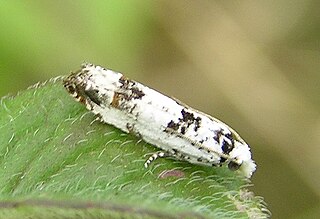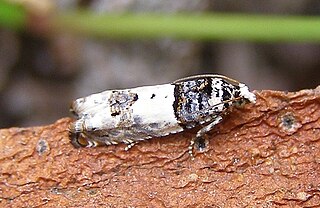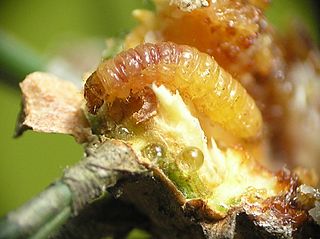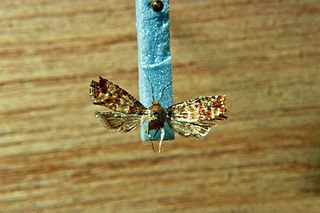
The Tortricidae are a family of moths, commonly known as tortrix moths or leafroller moths, in the order Lepidoptera. This large family has over 11,000 species described, and is the sole member of the superfamily Tortricoidea, although the genus Heliocosma is sometimes placed within this superfamily. Many of these are economically important pests. Olethreutidae is a junior synonym. The typical resting posture is with the wings folded back, producing a rather rounded profile.

Archips oporana, also known as the pine tortrix or spruce tortrix is a moth of the family Tortricidae, found in Asia and Europe. It was first described by Carl Linnaeus in 1758.

Zeiraphera isertana is a moth of the family Tortricidae. It is found in China, Russia, Europe and the Near East.

Rhyacionia buoliana, the pine shoot moth, is a moth of the family Tortricidae. It is native to North Africa, North Asia, and Europe, and invasive in North America and South America.

Eucosma campoliliana is a moth of the family Tortricidae. It is found in Europe, China, Japan and Russia.

Spilonota ocellana, the bud moth, is a moth of the family Tortricidae. It is found in the Palearctic realm, from North Africa and Europe to Iran, eastern Russia, China, Korea, and Japan. It is also present on Madeira and in North America.

Gravitarmata is a genus of moths belonging to the subfamily Olethreutinae of the family Tortricidae.

Gypsonoma sociana is a moth of the family Tortricidae. It is found from Europe to Russia, China and Japan.

Retinia resinella, the pine resin-gall moth, is a moth of the family Tortricidae.

Blastesthia turionella, the pine bud moth, is a moth of the family Tortricidae. It is found from Europe to eastern Russia, China, Korea and Japan. In the mountains, it occurs to elevations of up to 1,200 meters above sea level.

Epinotia nanana, the European spruce needleminer, is a moth of the family Tortricidae. It is found from northern and central Europe to Russia and Mongolia.

Retinia cristata is a moth of the family Tortricidae. It is found in Japan, Korea, northern and central China, Taiwan and Thailand.
Retinia monopunctata is a moth of the family Tortricidae. It is found in Japan, northern China and Russia.

Rhyacionia duplana, the summer shoot moth or Elgin shoot moth when referring to subspecies logaea, is a moth of the family Tortricidae. It is found from northern and central Europe to eastern Russia, China and Japan. It has also been reported from Korea, but it has not been found in recent studies.

Rhyacionia pinivorana, the spotted shoot moth, is a moth of the family Tortricidae. It is found from northern and central Europe to eastern Russia, China, Korea and Japan.

Zeiraphera ratzeburgiana, the spruce bud moth or Ratzeburg tortricid, is a moth of the family Tortricidae. It is found from northern and central Europe to eastern Russia and China. Zeiraphera ratzeburgiana is a taxonomically similar species to Zeiraphera canadensis and can only be distinguished by an anal comb found in Z. canadensis.

Crocidosema lantana, the lantana flower-cluster moth or lantana tortricid moth, is a moth of the family Tortricidae. It was first described by August Busck in 1910. It is native to Mexico and the southern United States, but was introduced to Hawaii in 1902, Australia in 1914 and the Caroline Islands in 1948 and 1949 to aid in the control of Lantana weeds. It has also been recorded from Yunnan, China and in Sri Lanka.

Eucopina tocullionana, the white pine cone borer, is a moth of the family Tortricidae. It is found in North America from Minnesota to Quebec, south in the Appalachian Mountains to northern Georgia.

Eucosma monitorana, the red pinecone borer moth, is a species of moth of the family Tortricidae. It lives in North America, including Pennsylvania, Ontario, Wisconsin and Maryland.

Phalonidia curvistrigana, the golden-rod conch, is a species of moth of the family Tortricidae. It is found in China, Japan, Korea, Russia and most of Europe. The habitat consists of woodland and scrubland.



















